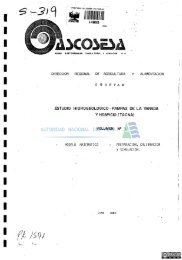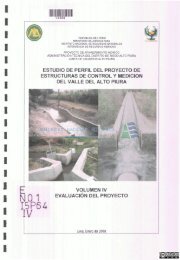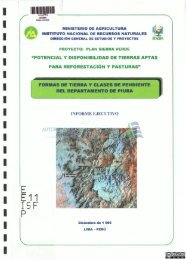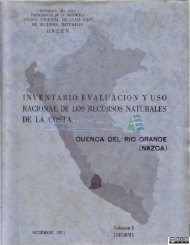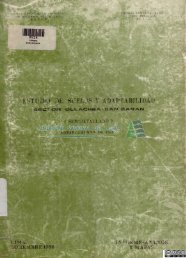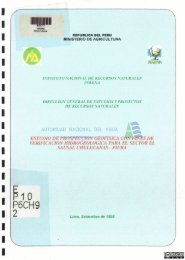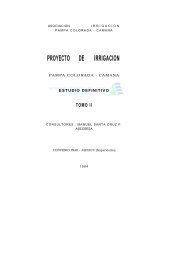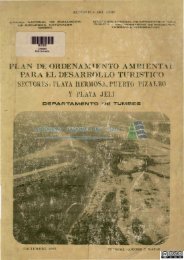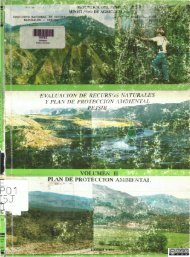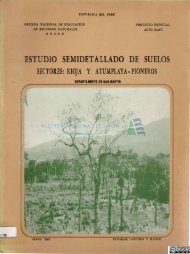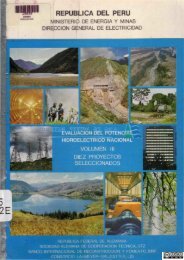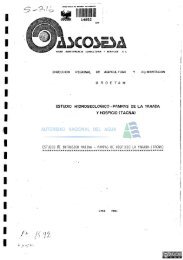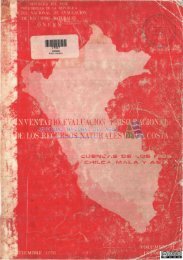- Page 1 and 2:
'REPÚBLICA DEL PERUOFICINA NACIONA
- Page 3 and 4:
PERSONAL DE ONERN QUE HA INTERVENID
- Page 5 and 6:
INVENTARIO Y EVALUACIÓN DE LOS REC
- Page 7 and 8:
- Ill -4.2 GEOLOGÍA GENERAL , ' 10
- Page 9 and 10:
í4 R£$Vi IJZ/Ot, i Dj'i.i.tWON ,
- Page 11 and 12:
- VII -Y O L UH E NI IANEXOANEXOANE
- Page 13 and 14:
A G R A D E C I M I E N T OLa airpl
- Page 15 and 16:
- II -Ubicada sobre la parte Sur es
- Page 17 and 18:
- IV -Tectónicamente se nota un gr
- Page 20 and 21:
- VII -La mayor extensión de pasto
- Page 22 and 23:
- IX -las aguas, para uso piscícol
- Page 24 and 25:
- XI -efectúa con dinero y/o comid
- Page 26 and 27:
CAPITULO 1INTRODUCCIÓN1.1 GENERALI
- Page 29 and 30:
Pág. 4INTRODUCCIÓNLnl • . ició
- Page 31:
77000•LEYENDALA UNIONKFPUBLICA DL
- Page 34 and 35:
Peg. 8 DIAGNOSTIC» SOCIALsucedido
- Page 36 and 37:
7« e 00'~1SIGNOS CONVENCIONALESCap
- Page 38 and 39:
Pég. 10DIAGNCfcriCU SOCIALen favor
- Page 40 and 41:
PkQ. 120IAGNQ6TI00 SOCIALLos estima
- Page 42 and 43:
CUADRO Nro. 7DISTHITOSY.MtyosAl ISA
- Page 44 and 45:
Peg. lóDIAGNOSTICO SOCIALgrupo pro
- Page 46 and 47:
Písg 0 10DIAGNOSTICO SOCIALComo co
- Page 48 and 49:
Peg. 20DIAGNOSTICO SOCIALCUADRO Nro
- Page 50 and 51:
Pág. 22DIAGNOSTICO SOCIAL!CUADRO N
- Page 52 and 53:
Peg. 24DI/eNOSTICO SOCIALEl área p
- Page 54 and 55:
Pág. 26DIAGNOSTICO SOCIAL2.2 SERVI
- Page 56 and 57:
OüfOfiO tiro. £>SERVICIO oe «UA
- Page 58 and 59:
Peg. 30DI/GNOSTICO ft-En la investi
- Page 60 and 61:
Peg. 32DIAGNOSTICO SC «.Los servic
- Page 62 and 63:
Pig. 34DI/GNOSTICO SOCIAL2.2.4 Salu
- Page 64 and 65:
Pág. 36DIAGNOSTICO SOCIALHuangásc
- Page 66 and 67:
P&g. 38DIAGNOSTICO SOCIALEl défici
- Page 68 and 69:
Ciifliatoloqia-it'coíoqíao 0
- Page 70 and 71:
Pág. 42aiMATOLOGIA-ECOLOGIA3.1.1 M
- Page 72 and 73:
aWATOLOGIA-ECOLOGIA• _, - at- apr
- Page 74 and 75:
CUADRO Na 2 .PROMEDIOS MENSUALES Y
- Page 76 and 77:
VELOCIDADMEDIORango de OSVelocid NW
- Page 78 and 79:
Pbg. 50 CLMATÜLOSIA-ECOLOGUBásica
- Page 80 and 81:
Pág. 52CLIMATOLOGIA-fcCOLOGIACUADR
- Page 82 and 83:
Pág. 54Ct-JMATOLOGIA-ECOLOGIAFinal
- Page 84 and 85:
aiMATOLOGIA-EOOLOGIA Pi*. ?">Con el
- Page 86 and 87:
CLIMATOLOGÍA-ECOLOGÍA Pbg. 373.2.
- Page 88 and 89:
CUMATOLOGIA-ECOLOGIA Pég. 59En el
- Page 90 and 91:
C U ft 0 8 0 Ho. yBA^CE HiOftlCO kH
- Page 92 and 93:
CUADRO *o.9Bfum. mmm mim a.mnm Y cu
- Page 95 and 96:
amATaOGIA-ECOLOGIAPég. 653.3.2 Des
- Page 97 and 98:
CLMATOLOGIfc-ECOLOGIA Pbg. 67La inf
- Page 99 and 100:
CLWATOIOGIA-ECOLOGIA P&g. 69El clim
- Page 101 and 102:
DIAGRAMA BIOCLIMATICO PARA LA CLASI
- Page 104 and 105:
CUMATOLOGIA-EOOLOGIA Pág. 73La top
- Page 106 and 107:
aiMATOLOGIA-ECOLOGIAPá 9-75siempre
- Page 108 and 109:
CLWATOLOGIA-ECOLOSIA Pág. 77Las la
- Page 110 and 111:
CLIMATOLOG IA-ECXX.OG IA Pág. 79Se
- Page 112 and 113:
CLIMATOLOGÍA-ECOLOGÍA Pág. 81fit
- Page 114 and 115:
CLmAtDLOGIA-ECOLOGIA Pág. 8-5Con r
- Page 116 and 117:
aiMATOLOGIA-ECOLOGIAPég. 85las rib
- Page 118 and 119:
CLIMATOLOGÍA-ECOLOGÍA Pág. 87Ám
- Page 120 and 121:
CLIMATOLOGÍA-ECOLOGÍA Pág. 89ded
- Page 122 and 123:
aiMATOLOGIA-ECOLOGIAp *9- 91rex), "
- Page 124 and 125:
CL1MATOL0GIA-EC0LCGIA Pég. 93por c
- Page 126 and 127:
aiMATOLOGIA-EOOtíBIAPé 9-3.5.2 Re
- Page 128 and 129:
CLIMATOLOGÍA-ECOLOGÍA Pég. 97Con
- Page 130 and 131:
CLIMATOLOGÍA-ECOLOGÍA Peg. 99Apro
- Page 132 and 133:
CAPITULO 4GEOLOGÍA4.1 GENERALIDADE
- Page 134 and 135:
GEOLOGÍAP6g. 1034.2 GEOLOGÍA GENE
- Page 136 and 137:
GEOLOGÍA Pég. 1054.2.1.1 Mesozoic
- Page 138 and 139:
GEOLOGÍAPíjg. 107Jurásico Superi
- Page 140 and 141:
.••¿ i-,- 1 '. .*;.•* . •
- Page 142 and 143:
Phg. 110GEQLG3IAalgo dolomíticas d
- Page 144 and 145:
Pég. 112GEOLOGÍAPor fac. es sedim
- Page 146 and 147:
GEOLOGÍAPág. 113grandes extension
- Page 148 and 149:
GEOLOGÍA'Piscococha, Pumacocha, Az
- Page 150 and 151:
GfcOLOGIA P6g. 117Muchas de estas e
- Page 152 and 153:
GfcOLOSIA Pág. 119desde el Eoceno
- Page 154 and 155:
GEOLOGÍAPbg. 121-Reíleño de Frac
- Page 156 and 157:
-v.•••'.9-•*• "I J' *.f.i
- Page 158 and 159:
Pág. 124GEOLOGÍACentro, sobre los
- Page 160 and 161:
Pég. 126GEOLOGÍA-"La Ponderosa de
- Page 162 and 163:
Pég. 128GEOLOGÍAdejándose de pro
- Page 164 and 165:
GEOLOGÍAPág. 129desarrollarse, el
- Page 166 and 167:
G^AFK O ^ 3RESERVAS OL t 'NA JOSÉ
- Page 168 and 169:
* - ~* rPeg. 132GEOLOGÍACUADRO Kro
- Page 170 and 171:
í*^. 13*r^CLOsiAEl potencial de lo
- Page 172 and 173:
IPág. 136GEOLOGÍAAlrededores de H
- Page 174 and 175:
Pág. 138GEOLOGÍA-Sector HuanGayaE
- Page 176 and 177:
• ;,','•• - *í. : :ry:-.'•
- Page 178 and 179:
IuoGEOLOGÍAEl Yacimiento más impo
- Page 180 and 181:
Mem
- Page 182 and 183:
Pbg, 144 SUELOS3.2.2 Material Carto
- Page 184 and 185: Pág» 146SUELOSEsta clasificación
- Page 186 and 187: Pfefl. 148SUELOS- AsociaciónUnidad
- Page 188 and 189: C U A P t 0 1-3CARACTSKISTICAS CE^t
- Page 190 and 191: contlnuaci6n7,'.1.03..1, Í50u. n5,
- Page 192 and 193: SUELOS Pág. 155Limitaciones de Uso
- Page 194 and 195: SUELOS P&g. 157frágil de su estrue
- Page 196 and 197: J-..,Vertiente izquierda del río L
- Page 198 and 199: Vertientes empinadas dei grio Larao
- Page 200 and 201: Pfcg, 160iSUELOS~ Subclase A3s(r)La
- Page 202 and 203: Peg. 162SUELOScambio, sí permiten
- Page 204 and 205: Pég. 164SUELOSpueden dificultar el
- Page 206 and 207: Fág. 166SUELOSestas tierras se deb
- Page 208 and 209: SUELOS Phg. 167an sobrepastoreo, fa
- Page 210 and 211: SUELOS Pág. 169del suelo se increm
- Page 212 and 213: SUELOSPeg. mbajo contenido de nutri
- Page 214 and 215: SUELOSPeg. 173Especies Recomendable
- Page 216 and 217: SUfcLOSPag. 175C I A P H 0*-S¡AUCt
- Page 218 and 219: SUELOS Peg. 177superficial. Las tie
- Page 220 and 221: SUELOS P&g. 179Forma Asociada P3sec
- Page 222 and 223: SIKLOS P&g. 181La Capacidad de Uso
- Page 224 and 225: SUELOS Peg. 183Excepcionalmente, pa
- Page 226 and 227: SUELOSPág, 1S5microcuenca o predio
- Page 228 and 229: SUELOS Pég. 187Evitar el sobrepast
- Page 230 and 231: Pág. 190 F0RESTAl£SEn cuanto a lo
- Page 232 and 233: P'&g. 192FORESTALES-Persistencia de
- Page 236 and 237: í>&g. 195FORESTALESEn el Mapa Fore
- Page 238 and 239: FQGESmESP6g. 197en las inmediacione
- Page 240 and 241: PRI!CIPM£S ESPBCTES CCHPONENTES DE
- Page 242 and 243: '•M£- "• > ^.,-.*?;: ^^*t•?)
- Page 244 and 245: Pág. 202FORESTALESEntre las especi
- Page 246 and 247: Pég, 204RÉSTALESTodo encuadrado d
- Page 248 and 249: Pag. *i£*FORESTALESoe c-i/adoiesí
- Page 250 and 251: Pfefjo 208FORESTALESSupcuencaAndahu
- Page 252 and 253: Pbg. 210FORESTALESLos plantones par
- Page 254 and 255: FORESTALESCUADRO Kro. 4OBJETIVOS DE
- Page 256 and 257: OJADi» m 5SELECCICtJ BCÜU3GICA DE
- Page 258 and 259: *»&$,„ SI©FORESTAtES••i-ide
- Page 260 and 261: Fig. 2(continuacidn)Plantoción en
- Page 262 and 263: 218 FORESTALESEn el matorral mayorm
- Page 264 and 265: ijftcirostoloQia
- Page 266 and 267: Pig. 222*/GROSTOLOGIAConocer y dete
- Page 268 and 269: Pág. 224/GROSTOLOGIAEn la última
- Page 270 and 271: Peg. 226AGROSTOLOGIACUADRO Nro.2PRI
- Page 272 and 273: P¿g. 228ASROSTOLOGIACUADRO Nro.4Í
- Page 274 and 275: Pág. 230A3ROSTDL0GIAOvinosEn la zo
- Page 276 and 277: Peg. 232ÍGROSTOLOGIA7.3 ASOCIACION
- Page 278 and 279: Pág. 234/GROSTOLOGIAcojines el riz
- Page 280 and 281: Peg. 236A3R0ST0LOGIACUADRO Nro.9•
- Page 282 and 283: 238 /GROSTOLOGIACUADRO Nro.10ASOCIA
- Page 284 and 285:
Pfeg. 240AGROSTXOGIAde la asociaci
- Page 286 and 287:
Pég. 242»7.3.2.4 Asociación Fest
- Page 288 and 289:
Í.-Ü, / - ^ROSTOLOSIA^L,> •*•
- Page 290 and 291:
PÍM?. 246ASKOSTOLOGIA^VALtlO Uro.
- Page 292 and 293:
Pag. 248/GROSTOLCGIACUADRO Nro.14AS
- Page 294 and 295:
Phg. 250/GROSTDLOGIAsubordinadas es
- Page 296 and 297:
PásAGROSTOL.OGXA«i -'fin 9 -^^ ^o
- Page 298 and 299:
254 AGRQSTOLOGIAque suma 10,500 Ha.
- Page 300 and 301:
SReeursos Vidríeos
- Page 302 and 303:
Pfeg. 558HE.CURSOS HIDRICXJSd^ irri
- Page 304 and 305:
CUADRO Uro.01-RHCARACTERÍSTICAS DE
- Page 306 and 307:
(COMISOS HIDRICOS Peg» 351La cuenc
- Page 308 and 309:
«fcCURS» HIORICOSP&9 ' 26:5ETP =
- Page 310 and 311:
RCOtffcOS HIDRICOSPhg. 265como repr
- Page 312 and 313:
KcOURSOS HIOR1CCSPíig. 267Este mé
- Page 314 and 315:
momos HHWICÜSPág. 269b) Delimitar
- Page 316 and 317:
RECURSOS HIDRICOS P&g. 271puente co
- Page 318 and 319:
^'%s". *• ' * * * & * • •Esta
- Page 320 and 321:
Peg. 274RECURSOS HIDRICOSPara deter
- Page 322 and 323:
Estación de Aforos : SocsiItoicaci
- Page 324 and 325:
Peg. 278RECURSOS HIDRIOOSEl coefici
- Page 326 and 327:
CDOCUADRO Nro. 05-RHINVENTARIO DE A
- Page 328 and 329:
(EGUfSOS HI0RICO5 Peg. 281de la lag
- Page 330 and 331:
RECURSOS HIDRICOS Phg. 283condicion
- Page 332 and 333:
RECURSOS MDRÍCQSPag. 2858.7.7 Clas
- Page 334 and 335:
CUADRO Nro. 6-RHMICRORREGION YAUYOS
- Page 336 and 337:
RECURSOS HIDRÍÜOSPég. 289En el c
- Page 338 and 339:
RECURSOS HÍDRIDOS P&8» 291total p
- Page 340 and 341:
CUADRO Nro. 08-RHUSO PECUARIO DEL A
- Page 342 and 343:
RECURSOS HIDRICOS Pbg. 295Las autor
- Page 344 and 345:
, .^•»f.->.íjr ,, -. : >:»r---
- Page 346 and 347:
P6S. 298RECURSOS MTDPjr,^8.11 MANEJ
- Page 348 and 349:
CUADRO Nro. iO-RHPOTENCIAL HIDROEL
- Page 350 and 351:
Peg, 302RECURSOS HID&ICOS"Central H
- Page 352 and 353:
Pfeg. 304«CU 1 » 08 HIDRICOS2. Me
- Page 354 and 355:
Hidxo-BnergíaAguaNombre dal Proyec
- Page 356 and 357:
01020304050607080910U12131415161718
- Page 358 and 359:
. 310 FEQJRSGS HIDRICOSExisten 153
- Page 360 and 361:
diagnostico Mmcommo1^ Hjj A^í í*A
- Page 362 and 363:
p'Sg. 314 DIASNOSTICO AGROECONOMICO
- Page 364 and 365:
3S„ , ¡f 0 J «NÓSTICO AGROECON
- Page 366 and 367:
F^c» ^'SDIAGNOSTICO ASROtCONOMICOE
- Page 368 and 369:
320 DIAGNOSTICO ACROECONCMICOCultiv
- Page 370 and 371:
DIAGNOSTICO A3R0ECON0MICO''-h,, y s
- Page 372 and 373:
- .-• *..r^. • '* $ • $ % ' .
- Page 374 and 375:
* cry» J>4^Í-'I/GNOSTIC» /GROtCO
- Page 376 and 377:
*• PÉp» 325mmmnm tUMEmimicoprev
- Page 378 and 379:
Rae* 528«HAGNOSTICQ *SfttC»ICMIC
- Page 380 and 381:
Í?IAGNÓSTICO AGROtCONCMICOticir-c
- Page 382 and 383:
Pág. 332DIASNOSTICO AGROhCONCMICOp
- Page 384 and 385:
-.c, 334DIAGNOSTICO /GROECXMWICOCUA
- Page 386 and 387:
336DIAGNOSTICO ¿GROECONCMICOEn lo
- Page 388 and 389:
-.-*!&?* *Pég. 338DIAGNOSTICO «RO
- Page 390 and 391:
Pág. 340DIAGNOSTICO /GROfeCONCMICO
- Page 392 and 393:
osota Nra. li -n&VAMR DE INSÍWOS A
- Page 394 and 395:
Pág. 344DIAGNOSTICO AGROfeCONOMICO
- Page 396 and 397:
OMfiÜ Nro. B~DACOSXCS DE PROQUOCIO
- Page 398 and 399:
Pag. 348DIA3N0STIC0 ¿GROECONCMICOa
- Page 400 and 401:
¿5f'DIAGNOSTICO AbfíJtUJNWiWJCÜA
- Page 402 and 403:
Pág,DIA3NaSTIC0 ¿GROECONCMICOrrCi
- Page 404 and 405:
COAL'PO Nro.l9-DAPRESTAMOS EJECUTAD
- Page 406 and 407:
«„ DI/CNOSTICU MJHUbWNWlUJ1iuyor
- Page 408 and 409:
P6g„ 358DItóNISTIOO fGBOECXMmCQo
- Page 410 and 411:
P^g, 360DIAGNOSTICO AGRQECONOMICQ-
- Page 412 and 413:
OKBRO to. 24^0ADESEa© 0E ttmmjoaw
- Page 414 and 415:
"-«J. 364DIASNOSTICO AGROfcCONCMÍ
- Page 416 and 417:
Pág. 366DIA3N0STIC0 ASROECONOMICOt
- Page 418 and 419:
'5 r-TICO Af.^TECONCMICO Pég. 367e
- Page 420 and 421:
DíASNOSTíCü ASRCfcCONOMICO Pég.
- Page 422 and 423:
GRÁFICO"A"CIRCUITO QUE DESCRIBE LA
- Page 424 and 425:
OI^NOSTICO XSROfcCONOMICO Peg. 3719
- Page 426 and 427:
DIAGNOSTICO AGROECONOMICO P6g. 3739
- Page 428 and 429:
DIAGNOSTICO ¿G^CONGMICOI u^« ^ *
- Page 430 and 431:
OS if. >> .'
- Page 432 and 433:
DI/GNOSTlC', m^L'X'jKxMlCOPeg. 3799
- Page 434 and 435:
. íAGNÓSTICO AGROECONCMICO Péfl.
- Page 436 and 437:
REMCICN CE ESTODIOS EEBCTURDOS PCR
- Page 438 and 439:
FEDCERRATASDICEDEBE DECIRPAG.PAG.19



